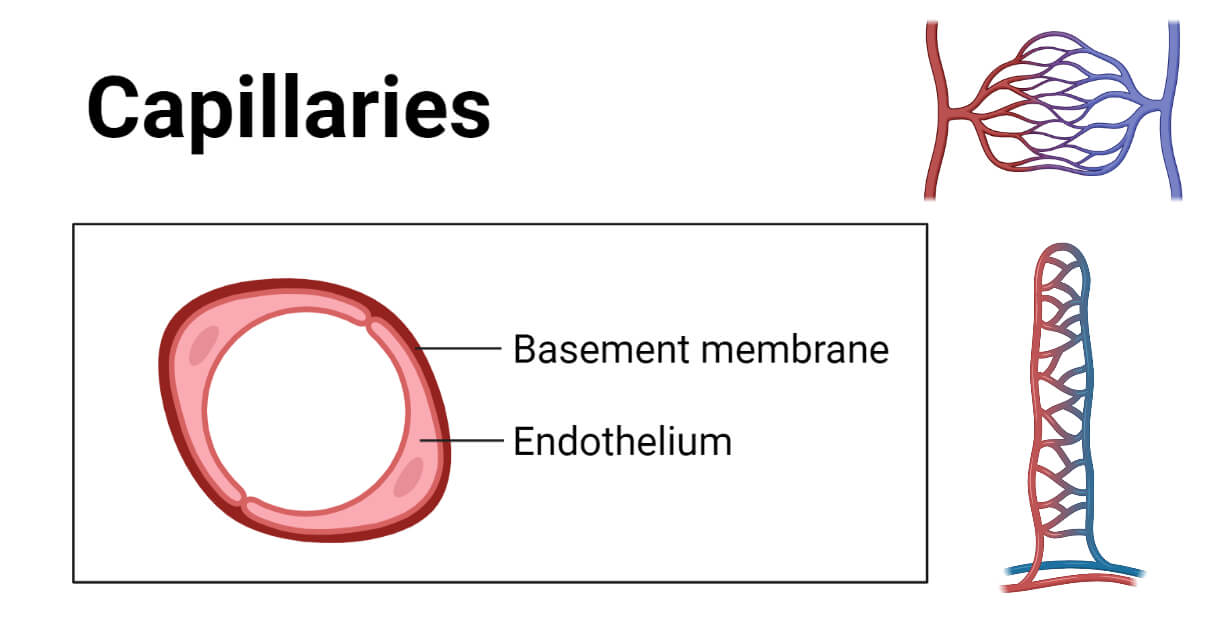Capillaries are incredibly small and finer blood vessels connecting the arterioles with the venules. They are the smallest blood vessels in our body.
Though it seems to be the branch of arteries and veins, they are structurally and functionally different than both arteries and veins.

Despite their tiny appearance, they play crucial roles in circulation, gaseous exchange, and nutrient exchange processes. These are the sites where there is an exchange of nutrients, gases, water, wastes, hormones, and other components between cells or tissues and the blood.
Structure of Capillaries
- Capillaries are extremely small, so they are not clearly visible to the naked eye. They have a diameter of just 5 to 10μm.
- Unlike other blood vessels, their wall is made of tunica intima, which is composed of a very thin layer of simple squamous endothelial cells. This thin wall makes them finer to reach between the cells and provides their permeability.
- They don’t have any valves. They have a narrow lumen that helps them hold the blood longer to complete the nutrient/gaseous exchange process.
Types of Capillaries
Based on their structure, capillaries are classified into three types: continuous capillaries, fenestrated capillaries, and sinusoidal capillaries.
1. Continuous Capillaries
These capillaries have an uninterrupted lining (without any gaps in their wall) of endothelial cells in their walls. They are the most common types of capillaries, abundantly found in skeletal muscles, lungs, skins, gonads, and the central nervous system.
They limit the permeability of larger molecules and only allow smaller molecules like water and ions.
2. Fenestrated Capillaries
These are the capillaries with the pores (fenestrae) of 60 to 80 nm covered with the diaphragm of fibrils. In the capillaries of the glomerulus, the diaphragm is replaced with the slit opening system. These pores increase their permeability, allowing them for rapid exchange of molecules. They also help exchange smaller molecules, smaller proteins, and water molecules.
They are mostly found in the kidneys, endocrine glands, pancreas, and intestines, where a rapid exchange of water and other molecules is needed.
3. Sinusoidal Capillaries
These capillaries have a discontinuous, irregularly shaped endothelial lining with large open pores. The pores may be up to 30 to 40 μm. They are primarily located in the spleen, liver, bone marrow, brain, and lymphoid organs. They allow for the exchange of various small and larger molecules, including blood cells and serum proteins.
Functions of Capillaries
- The major function of capillaries is facilitating the exchange of gases and nutrients between the bloodstream and tissues/cells.
- They form the blood-brain barrier, transferring selected and required components to the brain.
- They intake the wastes from cells and tissues and transport them to the venous system for elimination from the body.
- They also play important roles in distributing hormones to the respective targeted location.
Capillaries-associated Diseases
Capillaries may suffer from several medical conditions, of which some common types are summarized below.
| Disease | Introduction |
| Capillary Leak Syndrome (Clarkson’s Disease) | Condition when the blood leaks from capillaries into the surrounding tissues. |
| Capillary Hemangioma | A benign capillary-associated tumor in infants. |
| Hereditary Hemorrhagic Telangiectasia | A condition lacking intervening capillaries resulting in a lack of connection between arterioles and venules. |
| Microangiopathy | A condition when the capillary wall becomes thicker and weaker so that they bleed and leak. |
References
- Ross & Wilson Anatomy & Physiology in Health and Illness. 13th ed. Churchill Livingstone Elsevier. ISBN 978-0-7020-7276-5
- Koka K, Patel BC. Capillary Infantile Hemangiomas. [Updated 2023 Feb 13]. In: StatPearls [Internet]. Treasure Island (FL): StatPearls Publishing; 2023 Jan-. Available from: https://www.ncbi.nlm.nih.gov/books/NBK538249/
- McDonald J, Stevenson DA. Hereditary Hemorrhagic Telangiectasia. 2000 Jun 26 [Updated 2021 Nov 24]. In: Adam MP, Mirzaa GM, Pagon RA, et al., editors. GeneReviews® [Internet]. Seattle (WA): University of Washington, Seattle; 1993-2023. Available from: https://www.ncbi.nlm.nih.gov/books/NBK1351/
- Microangiopathy. (2023, May 5). In Wikipedia. https://en.wikipedia.org/wiki/Microangiopathy
- https://www.rxlist.com/microangiopathy/definition.htm
- https://my.clevelandclinic.org/health/diseases/22712-capillary-leak-syndrome
- Function of Capillaries: Definition, Structure, Types, and Conditions (healthline.com)
- Capillaries – Structure & Function Explained with Diagrams (teachpe.com)
- 3 Types of Capillaries (Plus Interesting Facts) – Nayturr
- The Function of Capillaries in the Circulatory System | Actforlibraries.org
- Capillaries Overview & Function | What are Capillaries? – Video & Lesson Transcript | Study.com
- Capillary. (2023, May 5). In Wikipedia. https://en.wikipedia.org/wiki/Capillary
- Capillaries: Anatomy, Function, and Significance (verywellhealth.com)
- What does capillary mean? (definitions.net)
- Capillaries: Continuous, fenestrated and sinusoidal | Kenhub
- Capillaries – Structure and function of arteries, capillaries and veins – Higher Human Biology Revision – BBC Bitesize
